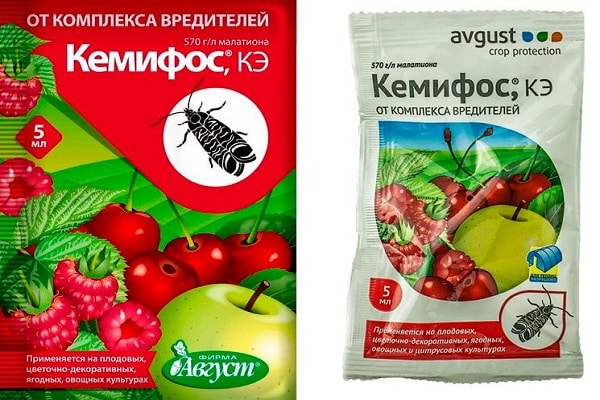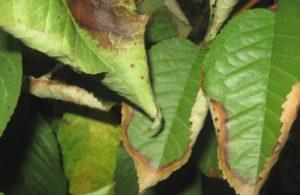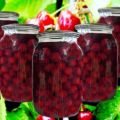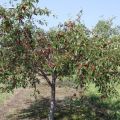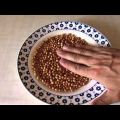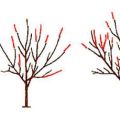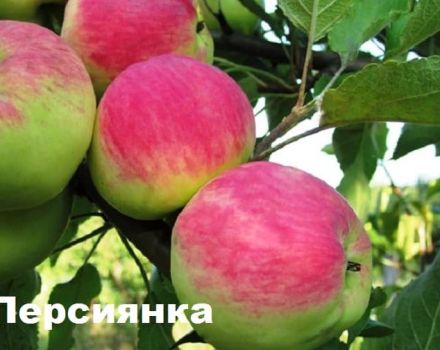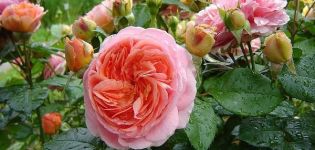How to process cherries from diseases and pests, what to do for treatment
Diseases of sweet cherry in the absence of adequate measures on the part of the gardener can cause a decrease in yield or the death of a fruit tree. There is a certain list of the most dangerous species of fungi and pests for culture, each of which is easy to identify and choose the right way to fight. To exclude cherry diseases, it is enough to know about the first symptoms of an anomaly in the growth of a tree and measures to prevent diseases.
Content
- 1 Causes of tree disease
- 2 Types of fungal and bacterial infections and how to fight them
- 2.1 Clasterosporium disease, fungal disease of sweet cherry perforated spot
- 2.2 Cherry bacteriosis or cancer
- 2.3 Gommoz
- 2.4 Chlorosis
- 2.5 Powdery mildew
- 2.6 Coccomycosis or reddish brown spot of sweet cherry
- 2.7 Moniliosis or gray rot of sweet cherry
- 2.8 Brown spot, phyllostictosis
- 2.9 Scab
- 2.10 Cylindrosporosis, white rust
- 2.11 Mosaic ringing of sweet cherry
- 2.12 Cherry gum flow
- 3 Disease prevention methods
- 4 What pests are cherries
- 5 Insecticides and insect control products
Causes of tree disease
Cherry trees are susceptible to a certain list of diseases, the appearance of which is most often associated with a violation of the rules of care or the influence of abnormal weather conditions. The appearance of signs of the disease should force you to reconsider the growing conditions and make adjustments.

Improper care
It is important to choose the right planting site and soil for planting the plant. The risk of poor growth and tree diseases increases dramatically in the following situations:
- landing in a wetland;
- close occurrence of groundwater;
- excessive fertilization;
- unsuitable soil;
- insufficient illumination;
- violation of landing technique, insufficient or excessive deepening.
Lack of preventive spraying in spring with drugs against fungal diseases and pests, refusal to whitewash the trunks can lead to diseases. Excessive watering, untimely or improper pruning of shoots can also cause disease.
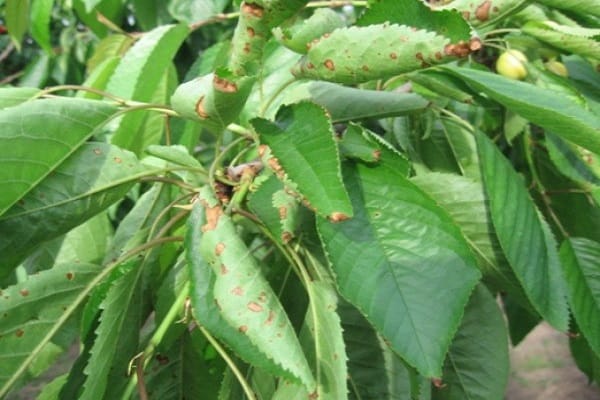
Unsuitable climatic conditions
The success of good fruiting and growing cherries often lies in the correct selection of the variety. For cold regions, only winter-hardy species should be chosen that can withstand low temperatures.
Neighborhood with infected trees
Sweet cherry refers to the "capricious" trees, as it suffers more often than others from the proximity to other fruit crops. She does not like the proximity of apple and cherry trees, is able to quickly adopt the "infection" from nearby shoots. At the first signs of infection, it is required to immediately take active action, since in a fairly short time the problem can affect all cherry plantings.
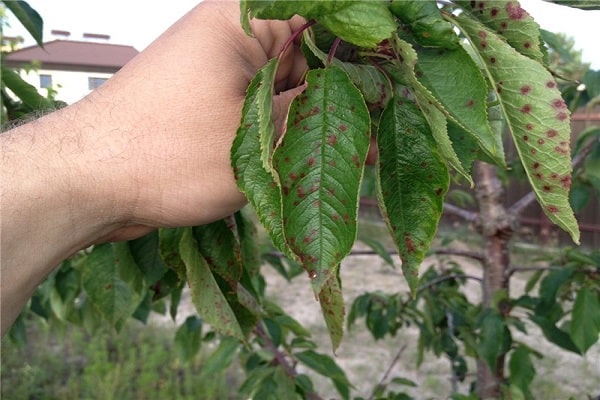
Types of fungal and bacterial infections and how to fight them
Some of the ailments of a fungal nature can be dangerous and not treatable, therefore, at the first sign of health problems, urgent measures should be taken, otherwise the planting of fruit trees may die.
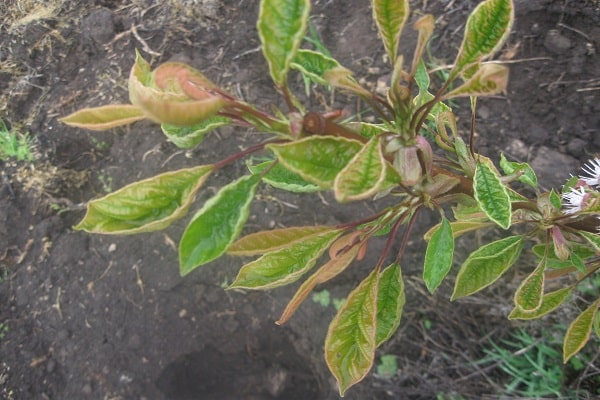
Clasterosporium disease, fungal disease of sweet cherry perforated spot
The disease infects trees in spring; the first symptoms are expressed in the appearance of small brown spots with a reddish border in the border area. Formations can be observed on leaves, formed buds and inflorescences. The affected areas dry out over time and fall out, and instead of them holes are obtained.
Infected berries change in appearance and become ugly. The berry pulp stops growing and dries up completely, reaching the surface of the seed. The infected tree stops developing and begins to bear poor fruit.
To combat the disease, timely removal of foliage and branches with signs of anomaly is required. Sections must be treated with a 1% solution of copper sulfate and the wound should be covered with garden varnish. For treatment, spraying procedures are carried out with 1% Bordeaux liquid. The frequency is as follows:
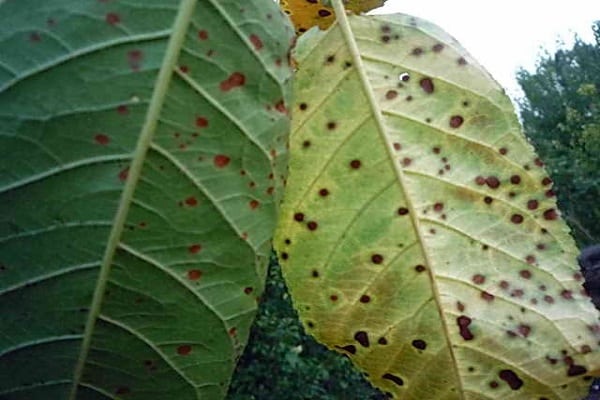
- at the time of bud ripening;
- 3 weeks after the end of flowering.
After removing the infected parts for treatment, it is effective to treat with the "Horus" preparation. The instructions for use are always attached by the manufacturer when selling, so the rules for preparing the solution must be studied in advance.
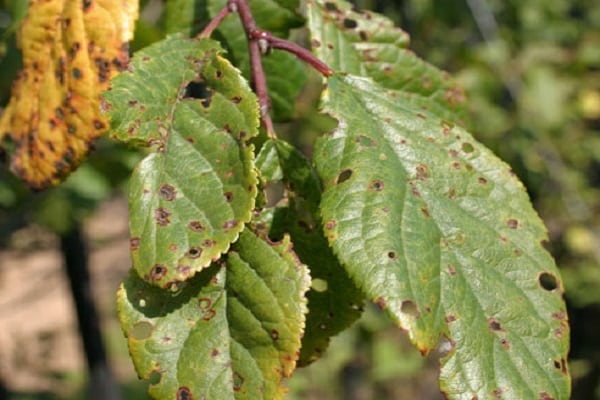
Cherry bacteriosis or cancer
Disease of the fruit tree of a bacterial nature often affects trees in the age range from 3 to 8 years. Microorganisms get on fruit trees with the help of rain and gusts of wind, during the cold period they winter in the bark or buds. The symptoms of the disease are as follows:
- ulcers appear on the branches;
- where the bark has burst, gum is released;
- leaf plates and berries are covered with dark spots, the edges of which are framed by a yellow border;
- formations of a brown tint appear on the stalks.
Over time, the wood of infected trees dies off, the leaves fall off. The danger of bacteriosis lies in the fact that there are no means to combat the effects of bacteria. Cherry varieties are presented on the horticultural market, the breeding qualities of which allow them to be more resistant to cancer. The risk of infection is reduced in warmer years without excessive rainfall. Application of nitrogen fertilizers and limited watering of the fruit tree will help reduce the likelihood of the appearance of the disease.
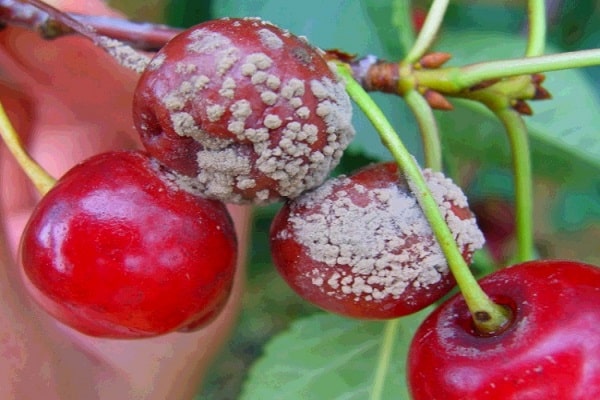
Gommoz
Hommosis manifests itself in the form of gum formation on the trunks and fruits of the tree. The danger lies in the fact that in this way fruit trees throw all their strength into fighting the disease, as a result of which the plants wither.
There are many reasons for the appearance of gommosis, therefore, in order to combat the disease, it is important to find out the main one. Possible ones include:
- cold damage;
- excessive application of nitrogen fertilizers;
- excess growth regulators;
- passion for phytohormones;
- mechanical damage.
To fight, mechanical extraction of the affected area is used, after which the wound is treated with copper sulfate and covered over. It is necessary to carry out such work several weeks before the onset of cold weather in the fall, which will allow the tree to recover.

Chlorosis
The most susceptible to chlorosis are trees growing on soils with an excessive amount of chalk and limestone. Groundwater lying close to the ground also increases the risk of disease. Infected plants grow poorly and, as a result of a lack of minerals, are characterized by poor chlorophyll synthesis. The result is a decrease in fruiting and, in extreme cases, the death of the fruit tree.
The first signs of chlorosis are the following:
- leaves begin to curl;
- the green mass changes color and acquires a light shade;
- the plant begins to look weak and sick.
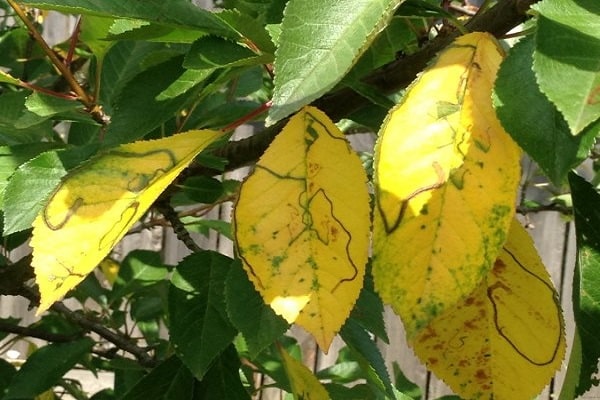
Problems of this kind are formed when manure, superphosphate, potassium dressings are excessively applied to the soil, therefore, you should work with such fertilizers carefully. The situation can be corrected by nitrogen-containing preparations, compost and peat. It is enough to put such funds into the ground 2 times a year with the calculation of 5 kg per square meter.
For prevention, in early spring, the tree is sprayed with a solution of iron sulfate, dissolving 300 g of the product in 10 liters of water. In mid-July, a second treatment is carried out, reducing the concentration of the active substance to 30 g.

Powdery mildew
The fungal disease affects mainly young shoots of sweet cherry, and the risk of infection is high during the cuttings procedure. The consequence is a slowdown in crop growth and early leaf fall. Description of the process of influence of the fungus:
- a white bloom appears, localized mainly on the leaves and shoots;
- gradually the mealy formation acquires a grayish tint;
- the leaves change their appearance and dry out over time.
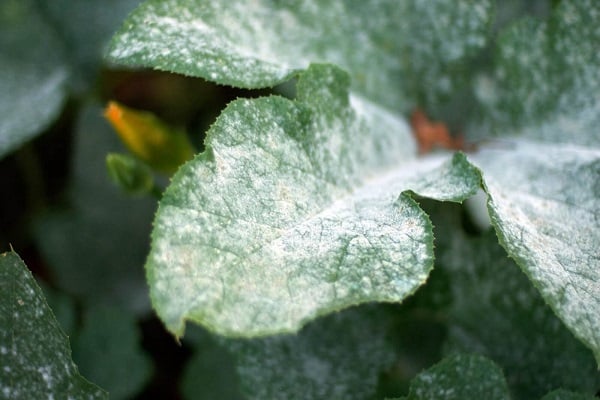
To combat the fungus, a fairly large number of various targeted drugs are presented today. The most common ones include:
- "Strobe";
- "Topaz";
- "Phytodoctor".
A good effect in the fight against the disease is shown by three times treatment with a break for 15 days with a 2% solution of colloidal sulfur or 2% lime-sulfur broth.
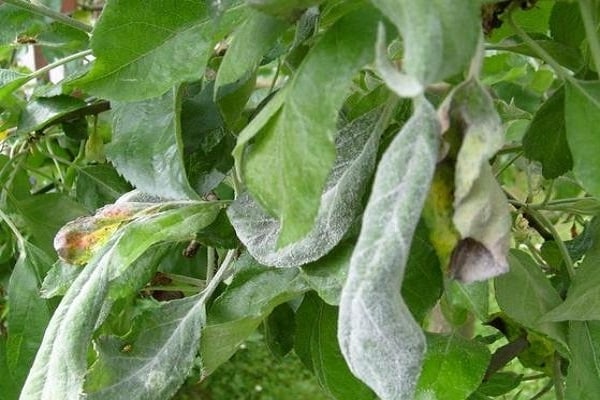
Coccomycosis or reddish brown spot of sweet cherry
The first symptom of coccomycosis infection is the appearance of spots on the leaves, which have a reddish tint. After some time, they turn brown, the green mass begins to fall off. During the first years, the fruit tree is sick, then it stops forming berries. Multiple leaf spots that weaken the plant can eventually kill the tree.
The fight against the fungus begins in early spring, the beginning of the process of swelling of the kidneys indicates the possibility of carrying out work.
The first treatment is carried out with copper sulfate, a solution is prepared with the calculation of 300 g of the product per 10 liters of water. At the time of the beginning of flowering, Bordeaux liquid is used. For the purpose of treatment, drugs are used to counteract coccomycosis - "Horus" or "Hom". For better adhesion of the solution to the liquid, experienced gardeners introduce laundry soap, the treatment is carried out carefully in those places where dark spots are concentrated.
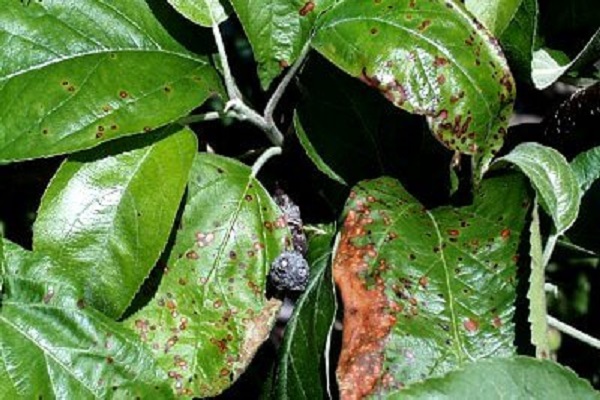
Moniliosis or gray rot of sweet cherry
The first signs of a problem are changes in the color of the shoots and twigs of sweet cherry, which acquire a brown color. Blackheads spread quickly, and the effect of fire appears on the surface of the cortex. In some places, gray growths are formed and cracks form, from which gum is actively released. Chaotically located formations are formed on berries. The symptoms of the disease are the following:
- the fruits are cracking;
- the process of berry decay begins;
- drying of cherries occurs.
The causative agent of moniliosis is a fungus that lives in dried fruits during the cold period. It is possible to get rid of the disease only if the infected foliage and shoots are destroyed in a timely manner. Prevention is autumn whitewashing, and fungicides are used to fight the fungus.

Brown spot, phyllostictosis
A disease of a fungal nature manifests itself in the form of small spots of brown shades on the leaves of the tree. Numerous black dots cause the green mass to dry out and fall off. To counteract such a fungal infection, you should collect the fallen leaves and burn it. During the gardening season, the tree is treated several times by spraying with special preparations.For these purposes, solutions are used:
- 1% Bordeaux liquid;
- 1% copper sulfate;
- "Nitrafena".
The first spraying is done before the bud breaks. The second procedure is repeated 2 or 3 weeks after the cherry has completely bloomed. To enhance the effect with a strong infection of the plant, after 2 weeks, it is desirable to carry out the treatment with the fungicide "Hom". When using chemicals, it is important to follow safety rules, work only in special clothing and protect mucous membranes from the solution. An autumn spraying with a 3% Bordeaux liquid after the foliage has completely fallen off will allow to fix the result.
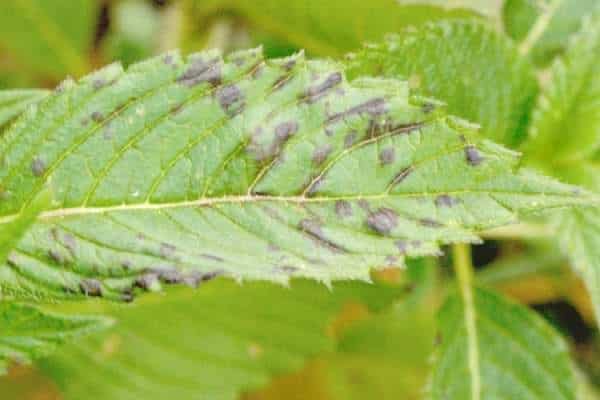
Scab
The disease manifests itself in the form of numerous dark spots on greenery and fruits, the leaves roll up in the form of a tube and dry out. In parallel, the affected berries rot and lose liquid. Mechanical and chemical methods are used to fight. In the first case, the affected areas are removed and destroyed with fire.
To combat and prevent further infection, three times treatment with 1% Bordeaux liquid is used - at the time of bud formation, at the end of the flowering process and a month before harvesting.

Cylindrosporosis, white rust
Rust leads to foliage falling, yellow crowns thin out already in the middle of the garden season. A fungal disease affects the layer of wood, ulcers form on it, from which gum is released. The cherry bark becomes black-brown in color. The plant weakens and cannot withstand low temperatures, as a result dries up in spring.
To prevent the disease, the removal of diseased branches is required. It is necessary to treat the emerging wounds in a timely manner, carrying out stripping, disinfection of the lesion site and covering up the wounds.
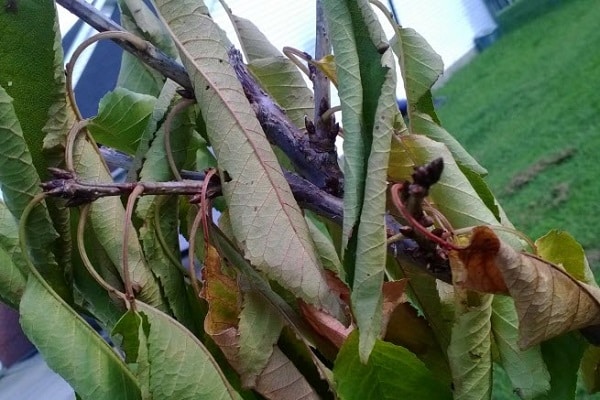
Mosaic ringing of sweet cherry
Mosaic disease is of a viral nature and leads to a decrease in the immunity of the fruit tree. On its leaves, formations appear in the form of yellowish stripes, localized along the lines of the veins. As infection progresses, the plates begin to curl, acquire a brown color and fall off.
Mosaic ringing leads to the formation of small light rings on the leaves, which later crumble, and holes are formed in their place.
Infection with the virus occurs as a result of the vital activity of harmful insects, due to inoculation with a diseased cuttings or pruning with tools that have not been previously disinfected. The disease cannot be treated, therefore, only preventive measures in the form of pest control and the elimination of the main causes of the appearance of mosaic ringing are used to combat.
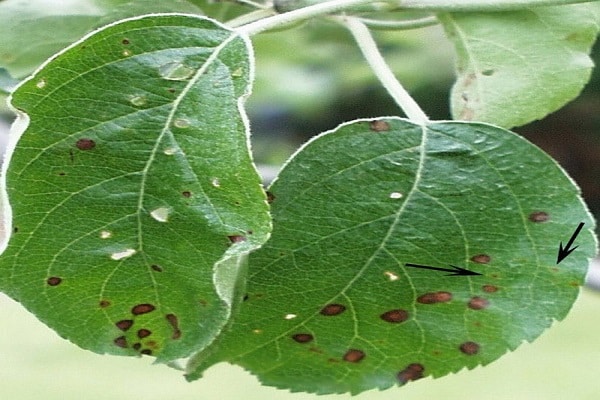
Cherry gum flow
Hommosis and gum disease are the names of the same disease, so the reasons for their appearance are the same. If there is a problem, a gum appears on the tree, which resembles glue and has a bitter taste, similar in consistency to resin.
Such formations can appear on fruits and leaves, but are more often observed on the surface of the trunk wood. Most often, this situation is caused by the inability of the tree to survive frost or mechanical damage. The resin deprives the tree of vital juices and attracts harmful insects, which negatively affects the growth of cherries.
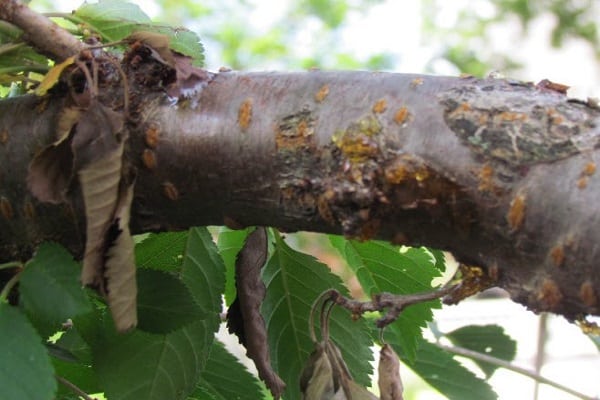
Disease prevention methods
For prevention purposes, it is important to control the growth of the plant, and when the first signs of an anomaly appear, take timely action. Good preventive measures are:
- cleaning and destruction of foliage, cut branches and rotten berries by burning;
- timely pruning and correct formation of the crown of the tree;
- loosening the root area;
- carrying out preventive spraying before flowering, after its end and after harvest;
- increased plant immunity.
Treatment with special preparations - "Ecoberin", "Zircon" can help to increase the plant's resistance to various kinds of diseases and environmental influences. An important factor in preventing diseases is compliance with the rules of growing and caring for the plant.
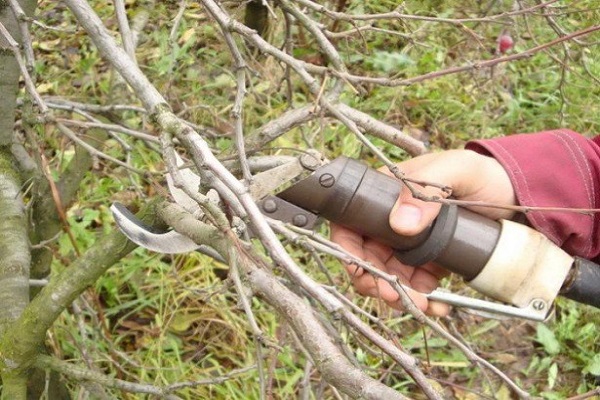
What pests are cherries
Wormy cherries were found in many gardeners, pests can affect not only the fruits, but also the leaves of the tree. The main dangers include invasions of the following insects:
- fruit mite;
- aphid;
- weevil;
- leaf beetle;
- leaf roll.
You can get rid of the invasion of worms with the help of special targeted drugs. Spraying is carried out several times per season, following the manufacturer's recommendations.

Insecticides and insect control products
Pest control of a fruit tree involves spraying. For this, solutions are prepared with which the entire plant is treated. In most cases, irrigation three times a day is sufficient in compliance with the schedule.
The first is carried out before the formation of buds, the second after the end of flowering and the last no more than 20 days before the collection of berries.
The peculiarity of modern insecticidal drugs is that the drugs allow you to immediately fight several pests. It is enough to perform one preventive spraying to ensure the protection of the tree from the invasion of various types of insects. Recommendations for use, information on the direction of action of the drug are always indicated in its instructions. Popular products include "Karbofos", "Kemifos", "Fufanon", "Inta-Vir".
